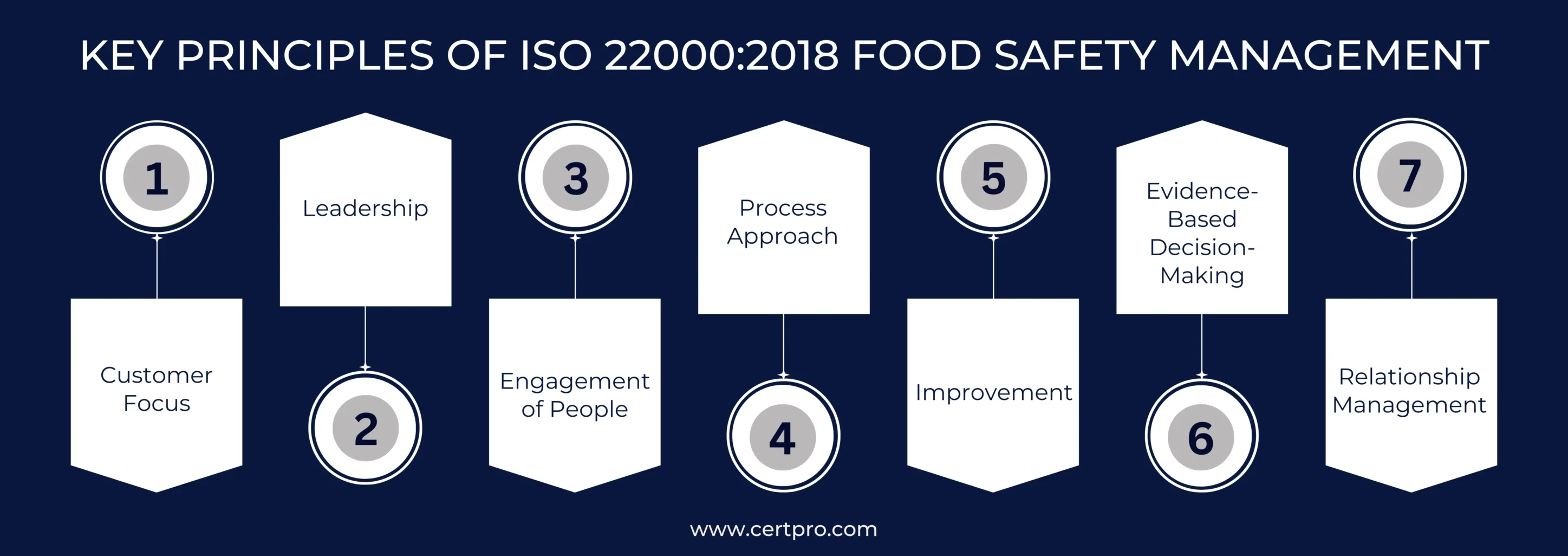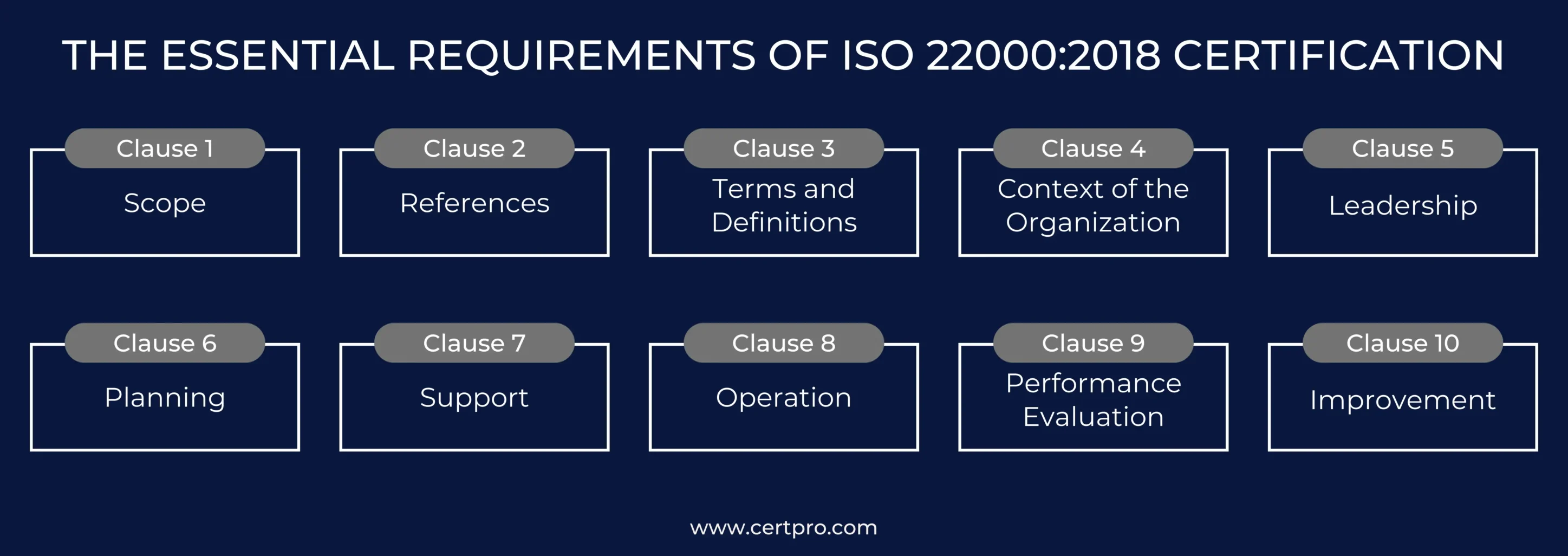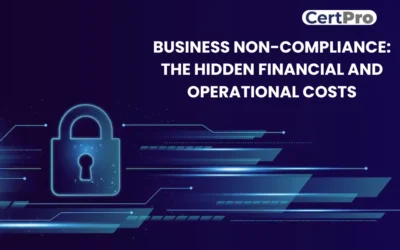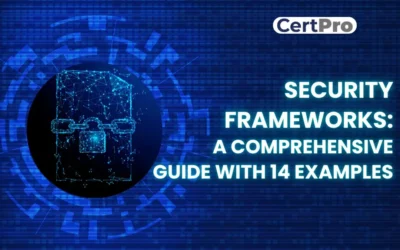ISO 22000:2018
FOOD SAFETY MANAGEMENT SYSTEM
Sustaining effective food safety management requires obtaining ISO 22000:2018 certification. The accreditation makes strict adherence to food safety standards throughout the supply chain possible, preventing foodborne illnesses and protecting consumers. Nonetheless, there is now a far greater demand for this certificate. With the advent of technology and online platforms, food safety incidents can spread quickly, damaging a company’s reputation. ISO 22000 helps organizations implement robust processes.
Consequently, it ensures food products meet safety requirements and comply with regulations. Hence, this certification enhances customer trust and confidence in the organization.
There are many benefits to being certified to ISO 22000:2018. It increases consumer assurance and faith in the security of food items. Thus, it boosts one’s standing and competitiveness in the market. This certification aids companies in adhering to legal and regulatory obligations. Also, it lessens the possibility of fines for noncompliance. It aids in locating and reducing possible risks to food safety.
Moreover, this shields customers from foodborne infections. In the modern period, ISO 22000 encourages a culture of continuous improvement. Hence, companies can enhance their procedures for managing food safety.

ISO 22000:2018 Certification and Auditing Services by CertPro
CertPro is an experienced certification and auditing company that specializes in ISO 22000. Our goal is to provide each company with customized ISO 22000 certification solutions. However, we give them particular assistance in terms of their food safety management. We also operate a food safety management system to meet ISO requirements further. Our help bolsters your food safety management and guarantees a smooth certification procedure.
Why choose CertPro for ISO 22000:2018 certification and auditing?
CertPro is an excellent option for ISO 22000 audits and certification. Our specialists are highly skilled in efficiently overseeing food safety. With careful assessments, unambiguous instructions, and reasonable adjustments, we offer solutions tailored to your company’s demands. Thus, we ensure that your certification procedure proceeds without a hitch and offer you complete support. As such, we will assist you in obtaining the ISO 22000:2018 certification.
| Factors | CertPro Advantage |
|---|---|
| Time to Certification | 4x faster than traditional approaches |
| Price | Competitive rates with flexible options |
| Process | Streamlined and efficient methodology |
| Expertise | 10+ years of industry experience |
CertPro’s Cost-Effective Approach to ISO 22000:2018 Certification
CertPro offers a budget-friendly option for ISO 22000 certification. We understand the financial challenges businesses face. This helps us improve how resources are used and speed up the certification process while meeting all the rules. We also cut costs by focusing on the most essential things and offering customized services. This way, CertPro helps companies get ISO 22000 certification quickly and ensures food safety management fits their budget. If you need practical and affordable ISO 22000, collaborate with CertPro.
| No. of employees | Timeline | Cost (approx.) |
| 1 – 25 | 4 weeks | 2500 USD |
| 25-100 | 6 weeks | 4500 USD |
| 100-250 | 8 weeks | 7500 USD |
| 250 plus | 8-12 weeks | Custom plans |
ISO 22000:2018 UNDERSTANDING FOOD SAFETY MANAGEMENT SYSTEM
ISO 22000 standards are globally recognized for food safety management systems. Although they provide a comprehensive framework, ensuring safety from production through consumption. This certification denotes a dedication to strict guidelines, which include risk assessment, control measures, and hazard analysis. Therefore, it incorporates HACCP system ideas into management commitment to continuous improvement and improves communication.
Achieving ISO 22000 certification has many advantages. It raises competitiveness, improves reputation, and fosters customer confidence. Producers, processors, distributors, and service providers—all links in the food chain—assure compliance with legal and regulatory standards. Robust systems and controls are implemented to systematically manage food safety threats, prevent illnesses, and protect customers.
The updated ISO 22000 standard simplifies integration with other ISO management systems. It introduces the PDCA cycle and risk-based thinking, integrating them with HACCP principles. This integration strengthens safety measures and enables effective hazard identification, prevention, and control. Continuous improvement is emphasized, ensuring organizations maintain and enhance food safety standards.
Moreover, organizations can promote customer trust and safer food supply chains by complying with ISO 22000 standards. This strategy improves public health and safety and helps businesses.
KEY PRINCIPLES OF ISO 22000:2018 FOOD SAFETY MANAGEMENT
Essential Guidelines for Food Safety Management in ISO 22000:2018:
Customer Focus: Give their needs top priority. Recognize and satisfy their desires. Encourage efficient communication and continuously enhance procedures.
Leadership: Showcase your capable leadership by aligning resources, policies, and strategies. Develop a trusting relationship and provide workers with more control.
Engagement of People: Involve every worker to increase output. In addition, encourage candid conversation and actively impart your expertise.
Process Approach: To boost productivity, adopt a systematic approach. Then, recognize your weaknesses and strengths to increase productivity.
Improvement: Constantly strive for continual improvement through training. Then, plan, execute, assess, and acknowledge initiatives to guarantee ongoing progress.
Evidence-based Decision Making: Make data-driven judgments using evidence-based reasoning and analyze information.
Relationship Management: Relationship management involves managing relationships with stakeholders and ensuring that goods and services flow steadily.

THE PROCESS TO GET ISO 22000:2018 CERTIFICATION
How to get ISO 22000 certification: To become certified for ISO 22000, you typically need to finish the following steps:
Step 1. Top Management Decisions: The food safety management system comes into effect based on the decision of top-level managers to implement FSMS in their organization. Consider your obligations under the food laws and the level of certification you choose to put in place.
Step 2. Training on Standard Requirements: Key personnel receive training to acquaint them with the specifications of the relevant standard, such as ISO 22000. This course guarantees a complete understanding of the standard’s requirements. It enables them to successfully implement the policies and security measures needed to meet the requirements and receive certification.
Step 3: Choose a Food Safety Team (FST): The FST supervises the FSMS application and organizes the organization’s activities. Additionally, it ensures the system works well and helps achieve food safety more easily.
Step 4: Finding Differences: Using a gap analysis, the company carefully examines what it now does. This helps determine if its present practices align with the requirements of the ISO 22000 standard. It determines where improvements are needed to comply with the standard’s requirements.
Step 5. Closing PRP Gaps: Any gaps found in the prerequisite programs are actively addressed and closed by the organization (PRPs). They take the required actions to guarantee adherence to the standard’s specifications.
Step 6: Organizational Risk Assessment: To identify and assess hazards related to food safety, do an organizational risk assessment. This guarantees preemptive steps to lessen those dangers.
Step 7: Identifying Food Safety Risks: At this stage, the company finds operational risks related to possible threats to food safety. This guarantees that appropriate steps are taken to lessen or eliminate the identified hazards.
Step 8. Documentation of the FSMS: All FSMS’s policies, processes, work instructions, and records have been recorded. These papers meet the standard’s requirements.
Step 9: Training and Awareness Elements: Every person in the company receives training on their roles within the FSMS from various departments. This increases the organization’s understanding of and dedication to food safety.
Step 10: Internal Audit: Conduct an internal audit to ensure that it works correctly and complies with regulations. This assists organizations in determining places where they can retain their standards by enhancing things.
Step 11: Corrective steps: These steps resolve the irregularities discovered during internal audits. This assures that our organization meets ISO 22000 standards and enables us to improve our operational operations.
Step 12: Management Evaluation and Improvement: The management team evaluates the effectiveness of our food safety system and suggests opportunities for enhancement.
Step 13: Submit Certification Application: The organization can call an outside specialist to check the information and offer us a certificate if everything is done correctly.
THE ESSENTIAL REQUIREMENTS OF ISO 22000:2018 CERTIFICATION
The ISO 22000:2018 certification specifies what a Food Safety Management System (FSMS) must have to ensure food safety at all times. Ten primary clauses, or parts, each deal with a critical component of food safety.
Clause 1: Scope: The main goal of the FSMS is to keep food safe. Organizations need to know the rules and goals to follow them correctly. They should also find any problems that might stop them from making healthy food. They should also mention what each person needs and give details about their products and services.
Clause 2: Normative References: This clause lists essential documents related to the FSMS. These references help managers better understand and apply the standard.
Clause 3: Terms and Definitions: This section provides essential terms and definitions for easy FSMS implementation. Precise terminology ensures a consistent understanding and application of the standard’s requirements.
Clause 4: Context of the Organization: Organizations need to know the inside and outside factors that affect food safety. By understanding these factors, they can make sure their food safety system works well with their activities and meets what others expect.
Clause 5: Leadership: This clause highlights the importance of leadership in making the FSMS effective. It involves strategies for food safety and providing the necessary resources. Moreover, good leadership ensures that food safety is a core value of the organization.
Clause 6: Planning: Planning facilitates the complete identification and assessment of food safety concerns. Choosing suitable control techniques is also critical for efficiently addressing food safety risks. Accurate guidelines are required to ensure uniform management of food safety risks across the company. Proper protocols must maintain the Food Safety Management System (FSMS).
Clause 7: Support: This clause focuses on maintaining effective communication, personnel knowledge and abilities, and adequate resources. As a result, these activities promote information sharing across stakeholders and within the organization. Furthermore, solid support networks are critical to maintaining an efficient FSMS.
Clause 8: Operations: The primary purpose is to create and maintain control mechanisms for food safety hazards. This section contains operational precondition programs (PRPs) and an overview of the Hazard Analysis and Critical Control Points (HACCP) technique. Thus, successful food safety requires proper working controls.
Clause 9: Performance Evaluation: This includes conducting internal audits, resolving concerns, and assessing the FSMS’s effectiveness. Furthermore, continual performance reviews assist firms in maintaining compliance with the standard and identifying development opportunities.
Clause 10: Improvement: Organizations must discover and embrace possibilities for improvement. This includes dealing with concerns, taking corrective steps, and gradually enhancing the FSMS through established procedures. Hence, constant improvement is critical for maintaining high food safety standards and responding to changing demands.

BENEFITS OF ISO 22000:2018 CERTIFICATION
ISO 22000 certification offers many benefits, which include:
1. Better health and safety: getting ISO 22000 makes food much safer. Thus, it reduces getting sick from food and ensures everyone stays healthy.
2. Customer Satisfaction: A company with ISO 22000 cares about safe food. Therefore, customers trust them more and are happier with their products.
3. Ensures Compliance with Laws and Regulations: ISO 22000 helps companies follow food safety laws. Consequently, it shows that the organization stays out of trouble and follows all the rules.
4. Meeting Standards: ISO 22000 works well with other systems like ISO 9001 for quality. So it’s easier to use them together.
5. Better Transparency: ISO 22000 makes tracking and controlling food easy, building trust with everyone involved in the food supply.
6. Handling Risks: ISO 22000 helps companies be proactive about risks. Therefore, organizations can find and fix problems quickly to keep food safe.
7. Saving Time on Investigations: Effective systems under ISO 22000 reduce the number of issues. So fewer investigations may be needed, which saves time and money.
8. Worldwide Recognition: ISO 22000 is known worldwide. Thus, it makes the company look good and helps with international business.
9. More Business Opportunities: ISO 22000 helps companies find new business partners. Since many people prefer ISO 22000, it allows the business to grow.
THE ISO 22000:2018 CERTIFICATION COST
The cost of getting ISO 22000 certified can be different for each company. It depends on the firm’s size, what the certification covers, and which certification body they choose. Certification bodies usually do the first audits, regular checks, and recertification. Also, improving processes, training employees, and consulting fees can add to the ISO 22000 cost. Companies should look at what they need, get guides from certification bodies, and think about the long-term benefits. Even though the ISO 22000 cost can be different, getting this certification helps meet rules, improve reputation, and keep food safe. In conclusion, businesses should balance the costs with the benefits, such as customer satisfaction, better operations, and staying ahead of competitors.
CERTPRO: ENABLING BUSINESSES TO ACHIEVE ISO 22000:2018 CERTIFICATION WITH CONFIDENCE
ISO 22000 accreditation validates your organization’s efficient food safety management. CertPro can help your firm implement a secure ISO 22000 certification. Our trained, expert staff will assist you and ensure the process goes well. Additionally, we guarantee you will receive ongoing help and direction as you work to become ISO 22000 compliant. We tailor the compliance approach to your organization’s needs. CertPro will provide complete certification services while adhering to food safety management. Our cost-effective methods and advice can help your organization’s food safety management. Choosing CertPro as your ISO 22000 consultant will build more confidence and trust among your partners. Thus, the overall measures can improve your business’s chances and growth.
FAQ’s
HOW LONG DOES IT TAKE TO ACHIEVE ISO 22000 CERTIFICATION?
The time required for ISO 22000 certification varies depending on factors such as the organization’s size, complexity, and readiness. It typically involves several months of preparation, implementation, and audit processes.
IS IT POSSIBLE TO INTEGRATE ISO 22000 WITH OTHER MANAGEMENT SYSTEMS?
Yes, ISO 22000 can be integrated with other management systems, such as ISO 9001 (Quality Management) and ISO 14001 (Environmental Management), to create an integrated management approach for organizations.
WHAT HAPPENS AFTER OBTAINING ISO 22000 CERTIFICATION?
After obtaining ISO 22000 certification, organizations must adhere to the standard’s requirements and undergo regular surveillance audits to maintain it. They can also use the ISO certification to enhance their reputation and demonstrate their commitment to food safety.
CAN ISO 22000 CERTIFICATION BE OBTAINED GLOBALLY?
Yes, ISO 22000 accreditation is available worldwide. The standard is internationally recognized and accepted, allowing organizations in any country to undergo the certification process and demonstrate their commitment to effective food safety management on a global scale.
IS ISO 22000 CERTIFICATION A ONE-TIME PROCESS?
No, ISO 22000 certification is not a one-time process. It involves the establishment and continual improvement of a food safety management system. After initial certification, organizations must undergo regular surveillance audits to ensure ongoing compliance with the standard and maintain the validity of their certification.
NAVIGATING DATA PRIVACY FRAMEWORKS: A COMPREHENSIVE GUIDE
Globalization has intense effects on business functioning and scaling. In today's digital world, companies are generating an unprecedented rate of data that requires protection from emerging cyber threats. In addition, recurring data breaches and privacy concerns make...
BUSINESS NON-COMPLIANCE: THE HIDDEN FINANCIAL AND OPERATIONAL COSTS
Businesses are always in a dilemma regarding whether or not to be compliant. Most companies think that compliance will problematize their operating process. However, highly regulated industries like financial and healthcare services meet the legal obligations for...
Security Frameworks: A Comprehensive Guide with 14 Examples
Technological advancements make cyberattacks more sophisticated and advanced. Hence, organizations must keep up with the latest cybersecurity frameworks in these complicated scenarios to sustain themselves in a dynamic threat environment. Different cybersecurity...



